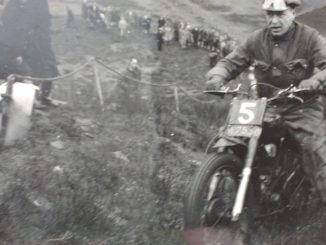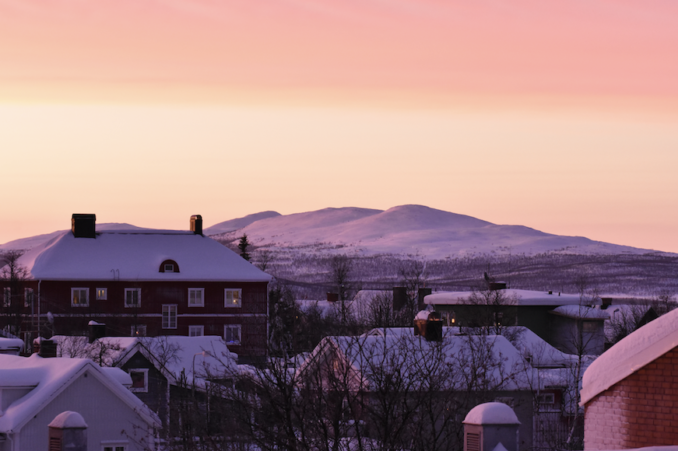
Picture of rooftops in Kiruna,
Witext – Licence CC BY-SA 2.0
Having been presented with the key to the door, my wilful 21-year-old self used the opportunity to close the lock tightly behind him and allow the trade winds to billow his sails north, all the way to beyond the Arctic Circle.
Long before a wall of information enlightened us from a thousand digital TV channels and that mixed blessing known as the internet, one’s knowledge of faraway places relied upon a couple of dated textbooks from the local library, North Pole thrillers (filmed in a hanger in Hertfordshire) and high latitude adventure novels amplified beyond the author’s prose by that wonderful thing now discouraged, a boy’s imagination.
Yes, heading north there was endless snow, frozen lakes and conifers too numerous for the less adventurous to imagine or for the traveller to count. But there were deciduous forests, particularly of silver birch stunted by cold and dark, and settlements in the most unlikely of places, not built of ice and wood but modern mini-Stockholms set in the middle of nowhere for reasons known only to the Lap, Finn or Swede.
A never-setting summer sun allowed for uncomfortably high temperatures and for thawed ground soggy enough to tempt most of the world’s mosquitoes to not only live above the Arctic Circle but to within striking distance of any pale, young exposed human skin.
One such surprising settlement was the town of Kiruna, 1,000km north of Stockholm by rail and 200km above the Arctic Circle. A company town, beside the railway line that took me there the locals enjoyed all mod cons plus ski slopes, a giant radio telescope and an airfield. From there Canberras, modified Boeing 707s and giant air balloons conducted meteorological research.
Cold Warrior Puffins suggesting such things handy for prying into the nearby Soviet Union need to be reminded that in those days Sweden was both neutral and not attempting to join NATO. Likewise, the helicopter-borne arrays spotted in the distance were for detecting minerals below the trees and topsoil not for scouting Russia’s nearby ‘submarine alley’ which skirts the northern cape en route to the naval bases near Murmansk. Taps nose.
Then as now, the airfield also hosted Santa specials, this being Lapland and two and a half kilometres of runway being in short supply in the surrounding million square kilometers between the Norwegian coast and the Kola Peninsula.
Consumer advice. Whether visiting Santa, en route to defeating the Warsaw Pact or escaping a Carlisle childhood, never sit at the front of a dog sled on the way to a grotto or Iron Curtain. Forget the trees (silver birch and otherwise), herds of reindeer and frozen lakes, your view will be of a dog’s bottom. Pinched tight closed against the cold most of the time but too often opening fire with lumps of rapidly freezing reindeer scraps recently recycled to faeces. Pray it hasn’t had a lot to drink as well.
Long-suffering readers may have noticed my childhood followed in my grandparents’ footsteps with holidays in places like Scarborough and Bournemouth. As the generations passed and I sought a 50th birthday holiday destination, one felt obliged to repeat the cycle and take one’s own children back to a 21-year-old’s blue remembered Arctic hills. Already over a decade ago, this was happening in 2012.
Having first arrived as a youngster myself in the 1980s with no more than the clothes I stood up in and the contents of a pack, we arrived 29 years later as a party of seven. Mrs AWS and our four children being accompanied by a curious niece. Not to forget the ton and a half of luggage. My own circumstances weren’t all that had changed. In fact, they were minor compared to how Kiruna had occupied herself during the intervening three decades. As we shall see, the company town had not only changed but moved.
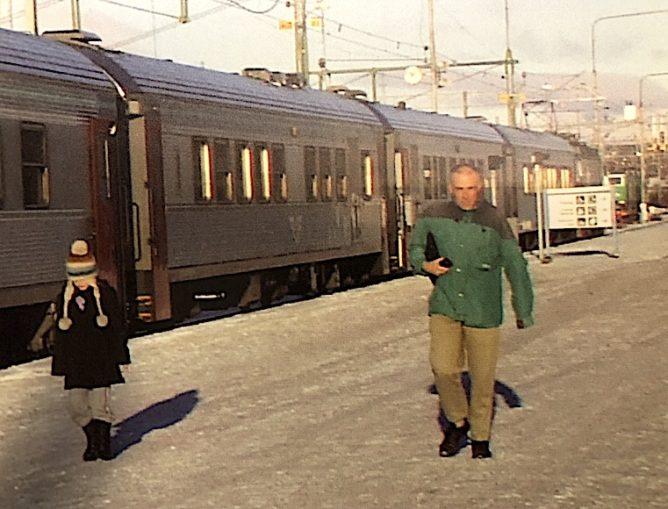
© Always Worth Saying 2023, Going Postal
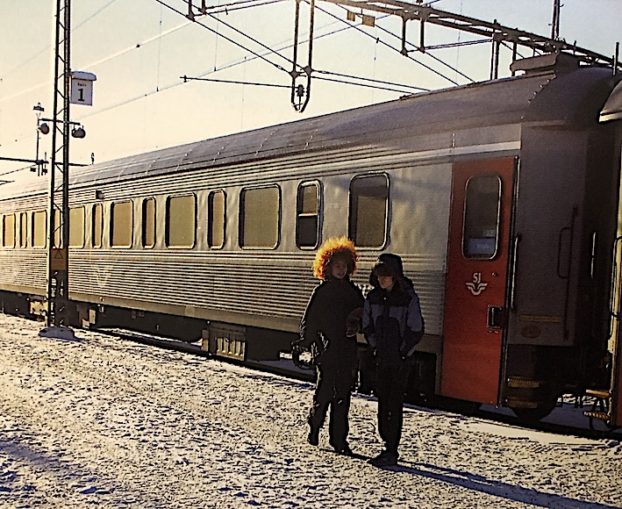
© Always Worth Saying 2023, Going Postal
That company is LKAB, Luossavaara-Kiirunavaara Aktiebolag. Literally, the Luossa Kiruna Joint Stock Company, their stock-in-trade being iron.
An ore mountain is the town’s raison d’etre. Here, there is no need to chase narrow leads through complex, unpredictable and rain-drenched geology as beneath our own western Lake District. The ore at Kiruna is part of a mountain. The seam is 80m thick, 4km wide, 2km deep and stands slightly off the perpendicular above and below the Arctic wastes. The start of the seem was originally at an elevation of 230m but by the time I first arrived in the 1980s the ore was being mined 80m underground.
By my 50th birthday in 2012, the excavation had reached further underground with a plan in hand to continue extraction down to 1,365m. That’s further below the surface of the earth, slightly, than the summit of Ben Nevis is above.
Rather than via one giant hole, this is done in levels driven into the bedrock. The levels extend horizontally from a shaft until they reach the ore and then move upwards and outwards to fan into the seam and extract the iron ore. Gravity is used to transport the extracted ore down to a lower level. It is then transported sideways by an automated electric railway to a shaft and lifted to higher levels. These higher levels, their ore having been exhausted, house processing equipment.
By the time it emerges to the surface, the iron is in a pellet form which can be transported by rail to the Baltic Sea at Lulea or the Arctic Ocean at Narvik. The advantage of Narvik being it benefits from the North Atlantic Drift, an offshoot of the Gulf Stream, and doesn’t freeze in the winter – unlike Lulea and the Baltic.
This is why the railway line exists. Known as the Malmbanan, in English the ‘Iron Ore Line’, a steady stream of mineral trains head towards the coast with (in 2012) six passenger trains a day slotted between them. Three trains a day ran from Kiruna to Lulea, one to Narvik and a through sleeper (the one we used) provided a service between Stockholm and Narvik.
But the extension onto new levels has consequences for the neighbours. With the seam being off the perpendicular, some of the deep ore deposits are under inhabited areas and where they mine the ground sinks.
In 2012, the seventh main level since underground operations began 50 years previously was being developed. As early as 2005, 150 buildings were already affected with residents being offered a buyout or their whole (wooden) houses being moved on the back of a truck. Yes, the railway station had to move too. The August following our birthday visit the old station closed to be replaced by a temporary structure elsewhere.
But how does Kiruna compete with the giant holes in the ground in the likes of Brazil and Australia with their ease of extraction and economies of scale in a rapidly globalising interconnected world? By being clever in the interviewing three decades.
A kindred spirit of mine, Mr Alex Berger of the LKAB company, explained the ore is processed into pellets covered in chemicals the purpose of which is to utilize the pellets’ advantage to achieve maximal value in use.
***
Before you mention it, I don’t have to be reminded that this wasn’t exactly what Mrs AWS and the children were expecting from a milestone birthday holiday. Added to which my natal day is at the end of October meaning the weather wasn’t great. In my defence, it was my big day and which 50-year-old male Puffin could refuse a tour of an iron ore facility in Arctic Sweden accompanied by a 2,000km round trip on the train?
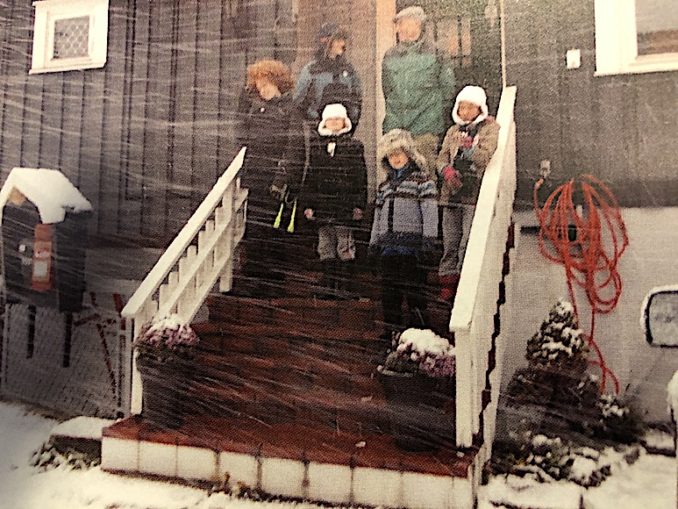
© Always Worth Saying 2023, Going Postal
***
Back to Mr Berger. As you know, pelletization is a Swedish patent dating from 1912. Iron ore is micronized into ‘fines’ which are then shaped into spheres and heated to make compact high-grade iron ore pellets which can withstand transport to the steel industry without breaking apart. Impurities such as phosphates can be removed in the process and other chemicals added allowing for higher production, the use of less energy, the creation of less slag and the production of higher quality steel at the steel mill.
By all means buy the cheap stuff from elsewhere but in the long run, it will cost you more.
And not just the steel mill, during my 50th, Kiruna was providing iron ballast for the ill-fated undersea Nordstream II pipeline along the Baltic.
Talk of Narvik will have caught the attention of warriors cold and otherwise. Eight decades ago neutral Sweden’s iron ore deposits were available to wartime Germany. A failed British attempt to capture the port of Narvik and cut off supplies to the Wehrmacht took place between April and June of 1940. With the Norwegian port being only 100 miles from Kiruna we left obliged to visit.
Although the full tale will be told in another Postcard, I must share a photo of the children ensuring all the Commonwealth fallen in Narvik New Cemetery received a poppy cross close to Remembrance Sunday. One of the advantages of a late October birthday!
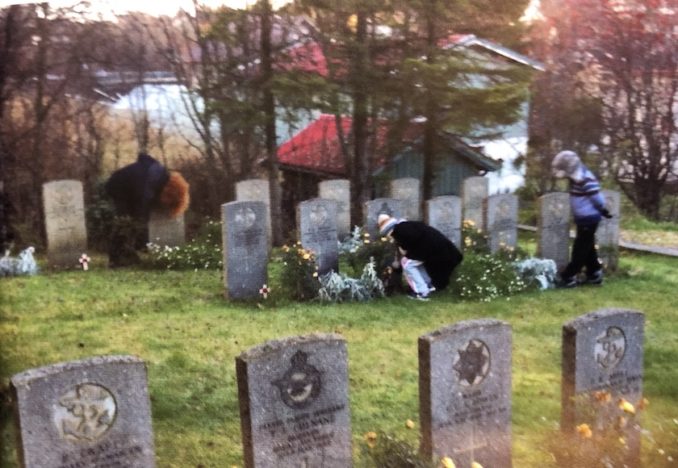
© Always Worth Saying 2023, Going Postal
With not much else to do other than walk, run, ski, swim and hunt, and with top-class sports facilities provided by the company to keep the workers fit and healthy, it comes as no surprise that LKAB provides Sweden’s national teams with much of their talent. A friend informs me that the LKAB sports centre wins more Olympic golds than France. He also informs that women’s wrestling is a particular speciality.
Something that, if the good Lord spares me, might tempt one back to the high latitudes for a 70th!
© Always Worth Saying 2023



